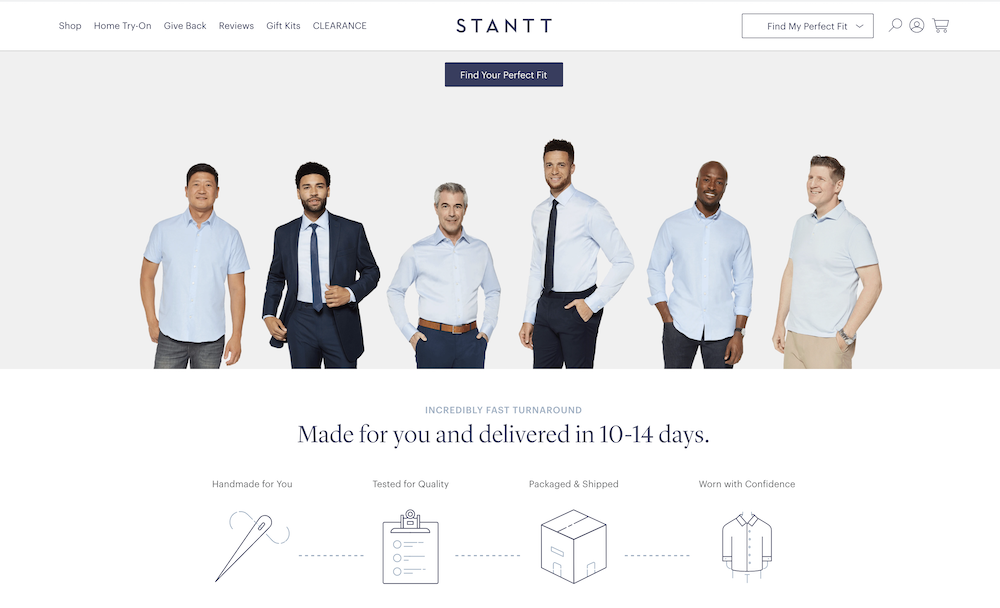3 Examples of Online Sizing Technology for Fashion Retailers

In 2020, in the wake of the global pandemic, people have increasingly turned to online shopping. Now experts predict that many people will keep the habit. With this in mind, it’s an important time for retailers to optimize their ecommerce site. Fashion and apparel merchants, in particular, can boost conversions through sizing tools to help customers determine the perfect fit.
Online sizing technology not only helps people finalize their purchase, they can also lead to fewer product returns. Additionally, the technology can increase customer loyalty as people are more satisfied with their items.
In this video, we’ve outlined three different approaches to online sizing. We hope this review helps you in evaluating the best strategy for your company.
Transcript: 3 Examples of Online Sizing Technology for Fashion Retailers
Hi, I’m Lauren. I’m a conversion specialist here at Command C. And today we’re going to look at the sizing technologies that apparel ecommerce stores are using to help customers feel more confident in their clothing purchases. So this is a really big deal because one of the most common reasons clothing is returned is because the size isn’t right. And because they can’t try it on, a lot of customers are left kind of guessing. This technology is meant to help customers feel more confident, actually want to put an item in their cart, complete their purchase, and feel like the item that they’re going to get is going to fit right.
Example #1: Virtusize Asks Customers for Current Favorite Clothing Size to Match with Nudie Jeans
Here on Nudie Jeans, we’re taking a look at their virtual sizing guide.
They’re using a technology called Virtusize. So what this involves is taking an item of clothing that is similar to the one you’re looking at. So here, I’m looking at jeans. So I measured a pair of jeans [that I already own] and we can see how those look overlaid over the product I’m looking at and we get an estimated size. So 34/34 with the 94% like your trousers. So that’s a quite high percentage. For me as a customer, I’d feel very confident. The issue would be if a customer maybe was 70% or something lower, they might not feel confident. So it might be tricky. And they would probably wonder what to do next, or maybe they would be suggested another clothing item.
The cool thing with Virtusize is that once you make an account and save your sizings, then you can access that on other stores that use Virtusize. So this is probably the sizing technology that would take customers the longest, but I think it also provides a lot more accurate sizing recommendations.
Example #2: Theory Uses Fit Finder for Optimal Medium-Length Questionnaire
Next we’re looking at Theory. So we’re going to use their sizing guide here. They’re using Fit Finder. You insert some pretty general questions just about yourself and your body type. This is a very quick process here. And I have an 82% here. So this is saying there’s an 82% chance that you’ll be happy with the size 6. This style of sizing guide was a bit of a medium length.
The team behind Fit Finder did a lot of user testing and found that trying to strike a good balance between getting the right information and not making the process too long, having a medium-length process actually converts better. If you have too fast of a process, a lot of customers don’t actually trust the results. The 82% here is actually quite a good rating and makes me feel pretty confident in picking a size 6, especially over an 8 or likely something a lot tighter.
Example #3: Stantt Provides Sizing Guidance Through Brand-Specific Solution
Right. And finally, we’re going to look at Stantt. So Stantt uses their own very interesting sizing guide, so let’s run through that. They have Stan here. This is a mix of the two previous examples. So it’s asking for general questions, but it actually is quite a long process. At least I felt like it was because when I was looking just at shirts, it asks a ton of questions about pants and all these other products. This can be helpful if you’re looking at buying a bunch of different products from their store, but it can also take a long time if you’re just looking to purchase one item. Then they provide you with their Stantt size which is their own custom sizing which is quite interesting. They use some data fit technology, so quite an interesting process.
All three of these stores are quite different. So whether you want to go with Virtusize and having customers feel confident in their purchase, but having to go and measure actual clothing to get the right fit, or whether you want to ask more general questions, it’s really up to you, what you think your customers will want to do. And we definitely recommend testing out some of these options and checking out some of the other options that are available on the market. All right – thanks for watching!
